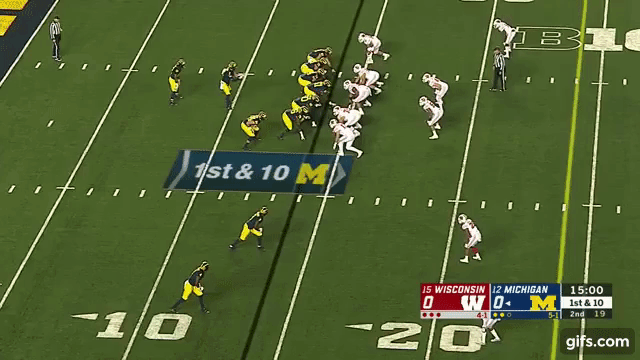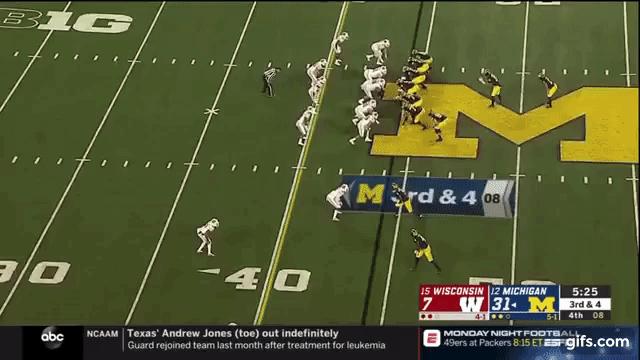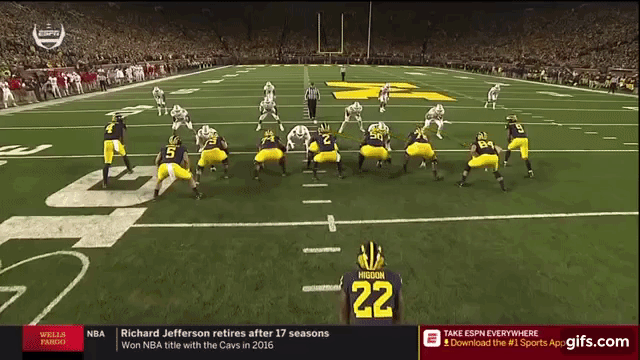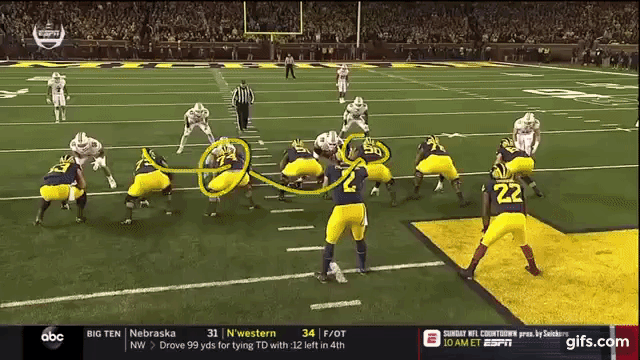Harbaugh began reading lyrics from his 49 days with Colin Kaepernick. Shea Patterson's big hit was "12/13 EAT". This is a reading arch created by the 12/21 staff twins. Narrow formations define predictable coverage. Archi F for CB. pic.twitter.com/dt1Hwp74CN— James Light (@JamesALight) October 14, 2018
performance model
Unlike standard deep block schemes, this is more than just blocking the abdominal area. In the later part of the game, OL worked as a double team before LB. Because it's a belly run, it brings the block closer to a traditional break combo block as the OL can really focus on getting the first tier defender to the second tier defender. Since the game is designed to go to the back of the line, it's almost like a traditional thumb blocking scheme: jump to the front line right inside the LB. Front was just a fan blocking DL in front of him to make sure they couldn't undermine the lineup.
In short, the RB is actually heading towards the Gap A connection point from behind. This allows QB to read the same page. This is a fair discount, no step reading zone, the goal is to quickly go down the hill and attack the emerging wrinkles in the game design. It will read MIKE reacting to combo blocks to distinguish if you are working directly on the field or moving the game or back spaces. It all depends, of course, on whether he gets the ball.
Since the broadcast of the section was a threat, WILL had to respect the inner zone by forcing her to leave the RB. This means that reading MIKE allows the game to stay on a very challenging journey. MIKE respects the Zone, you clipped her behind.
MIKE scratches, you cut between ILB.
H defenders coming from the opposite side of the formation will first take a path very similar to the division zone (which Michigan also often takes) before bringing EMOL to the second line of defense. It's important to note that Michigan governs a lot of separate areas, especially from weapons, so defense will often work on that aspect's side.
QB reads EMOL on the back. If he falls, go ahead. If you keep the width it gives.
preparation
Training here really helps to organize a run. The "bunga" or closed side of the formation largely determines what the defense will do. For one place on the field 3x1. This will often cause the lid to rotate. It is also often referred to as the leverage cloud, which means that CB will be the responsible power advocate and will be the only power advocate outside of EMOL. This is useful to know after you decide to "read".
So against Cover 1 , his CB lined up to cover Y-TE. When blocking, defenders now take the opportunity to block. No other filling of the database after it occurs, since the coverage is already defined.
And most Shelter 4 crews adapt by performing a "bump" check, effectively changing cover to Shelter 6 (quarters) . This leaves security in the deep half instead of standard security, and traditionally leaves you an inside gap to attack using support instead of a gang (since gang adaptation is often over the top); The game is played on the short side of the field for the same reason, as security traditionally stays close to the hash, resulting in a much lower angle of play.
Since the CB is the only defender in the squad, the blocking bow can easily get out of it and deal with the only people outside the EMOL. Due to the game's reading element, EMOL effectively gets stuck and is always on the wrong side of the turn (assuming the reading is done correctly).
If EMOL stays on the sidelines, RB has the ability to move quickly from north to south to eliminate the striking wrinkles created by the combined LB block and two side guards.
If EMOL appears, it is often a TE vs. CB block, which can easily cause a long-term QB. Training here is an important part of the success of the program.
example
How does it work for other Playbooks?
The first thing that helps is the separation area. In the first example above, you can see how the protective EMOL tries to incorrectly block the flow of baffles and wings, creating a back pile. This curved block will effectively expand this player.
This example is under the center, but the gist is done. Look how wide the back is. This creates a large cut path for the RB in the interior split area.
Another thing it does is slow down the chase from behind. Now when defenders see the blocking zone, they can't immediately attack from above to adjust to their playing space, as they're worried about the pressure this pulp is putting on the back of the formation. You see it here because of how slowly the rear LB reaches the top of the game. Even if it comes from a shotgun and not a shotgun, the theory still stands (and of course, belly readings can still be taken from a shotgun since the USO used its maximum in the Nationals a few years ago).













No comments:
Post a Comment
Note: only a member of this blog may post a comment.